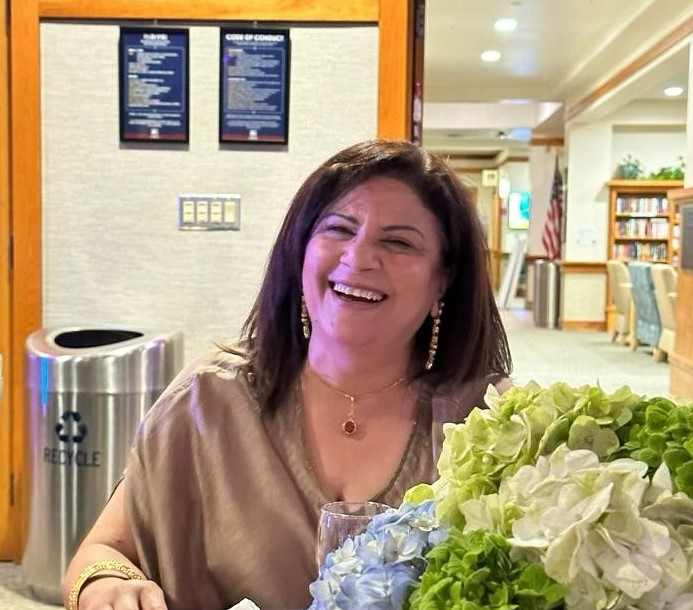Nandan Nilekani, Pramod Varma outline genesis of India’s Aadhaar ecosystem in Silicon Valley
The establishment of Aadhaar enabled India to leapfrog financial inclusion for 85 percent of its population
 MR Rangaswami, of Indiaspora and Chief architect of Aadhaar Dr Pramod Varma at the Computer History Museum in Silicon Valley on May 30. / Ritu Marwah
MR Rangaswami, of Indiaspora and Chief architect of Aadhaar Dr Pramod Varma at the Computer History Museum in Silicon Valley on May 30. / Ritu Marwah
Co-founder of Infosys, Nandan Nilekani, who led India’s Aadhaar (unique identification system) project and Dr. Pramod Varma, the project’s chief architect discussed the two decade long journey of India’s digital transformation, the brains behind it and the road ahead in Silicon Valley.
Aadhaar is a 12-digit identifying number given by the Unique Identification Authority of India (UIDAI) which serves as proof of identity and proof of address for residents of India. Today over 95 percent of Indian citizens are registered under Aadhaar, making it the world’s largest biometric ID system.
“People were standing in a queue to get their cards,” said Varma, reminiscing of the days they had first issued the Aadhaar card. He was engaged in a conversation with MR Rangaswamy\i, of Indiaspora at the Computer History Museum in Silicon Valley on May 30.
“Not everyone has a birth certificate or any other legal proof of their existence, " said Nandan Nilekani at an event at Stanford PAC the next day. Nilekani was the power and muscle behind the endeavor. He was a given a position of Chairman of the UIDAI, which was equivalent in rank to that of a cabinet minister.
He had put together a multidisciplinary team of experts that Varma was a part of. In April 2010 the logo and the brand name Aadhaar was launched by Nilekani.
Minimalistic design with two biometrics and four attributes : name, date of birth, address and gender (later the government added a field for transgender as well) was the sum total of information identifying a person.
“If they lived on the pavement or footpath as their address we put that. No one was denied a card,” said Nilekani. It was not limited by nationality, even if the person was not of Indian citizenship, but staying in India he could get the card, said Varma.
Was security of data a concern?
Aadhaar has been plagued by a myriad of internal and legal problems, as well as major leaks and vulnerabilities in the overall security of the system.
“The architecture of the system supporting the card was a distributed one with extensive cryptology and digital signature,” said Dr.. Varma. “The design was validated by world-class security experts like Bruce Schneider. At no point in time can even the data administrators see the details of more than five people. Very minimal information was on file anyway.”
“Risk is integral but you have to manage the risks,” said Krishna, a resident of Cupertino who worked on the Aadhaar project. “In India people don’t remember their Aadhaar number and fingerprints can change for labor who work with their hands. A retinal scan was added”, said Krishna.
Digital banking and payments enabled
Establishment of Aadhaar enabled India to leapfrog financial inclusion for 85 percent of its population—when only 20 percent had access to formal banking a decade ago.
65 percent of the bank account holders are women. Digital banking broke the gender barrier to economic liberation as well as the rural one.
“The use case to get bank accounts jumpstarted was the lure of government benefits (500 million). To receive the benefits directly to their accounts many accounts were opened,” said Varma.
The Unified Payment Interface or UPI, an instant payment system is used by citizens throughout the country, even for very small purchases. The instant payment system remade commerce and pulled millions into the formal economy.
MR cited the example of an Indian family paying for Eiffel Tower tickets in Paris with their phone today, something no one would believe was possible 10 years ago.
Delivering at scale using low cost infrastructure
All this was done at an affordable cost using open source. India is now taking this to the world! “ We anticipated the cost of the card to be $10 to us. We did it in $1,” said Dr. Varma. “We took 2 billion dollars in funding and used only one.”
“Billions of mobile app transactions — a volume dwarfing anything in the West — course each month through a homegrown digital network that has made business easier and brought large numbers of Indians into the formal economy,” said the New York Times.
The technologists of Silicon Valley sat amazed at the statistics being rolled out. Some in the audience marveled at the great opportunity Dr. Varma had had to shape the Aadhaar, a keystone of India’s digital infrastructure.
“ We were advised in the US that we would need a football field sized facility to house the data center. We ended up with a server room of 3500 ft!”
ADVERTISEMENT
ADVERTISEMENT
E Paper
Video

 Ritu Marwah
Ritu Marwah 
.jpg)

.jpg)


.jpg)

.jpg)
.jpg)

Comments
Start the conversation
Become a member of New India Abroad to start commenting.
Sign Up Now
Already have an account? Login